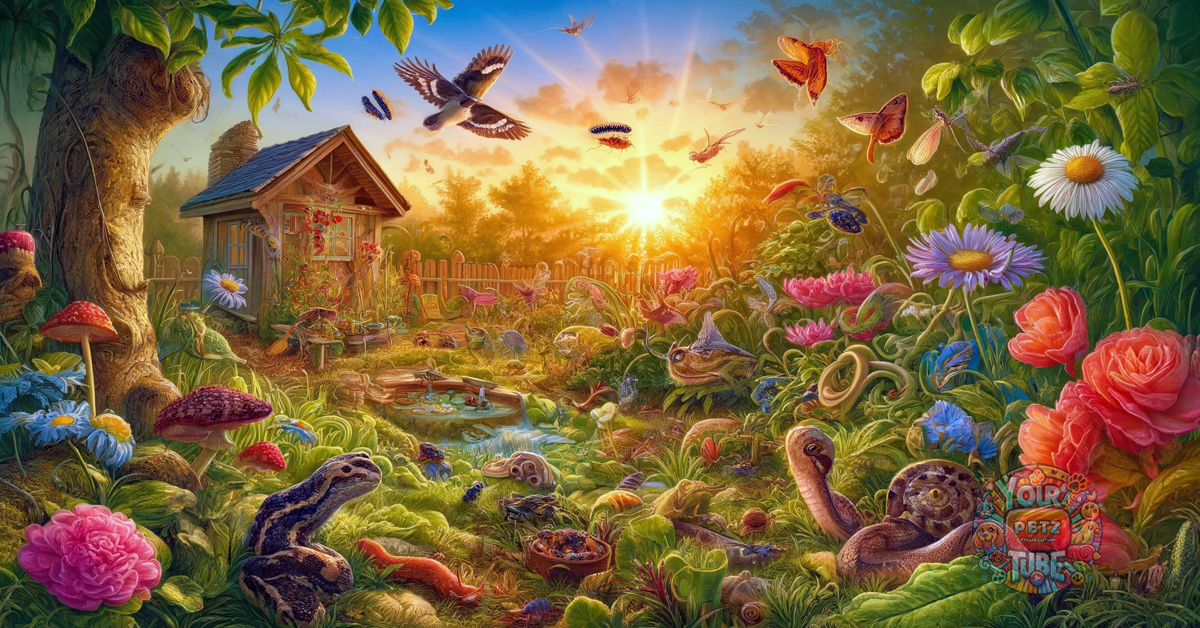
Bringing Backyard Pets Home: A Guide to Nature's Little Wonders
Bringing a piece of the wild into our homes isn't just about adopting a pet; it's about connecting with the natural world in a respectful, educational, and enriching way. From the slimiest snails to the flashiest fireflies, backyard pets can offer unique insights into the wonders of nature right in our own homes. This guide will walk you through how to responsibly and safely bring these creatures into your life.
1. Slimy Snails and Slithery Slugs
 This image showcases a variety of snails in their natural habitat, highlighting the diversity and beauty of these garden inhabitants.
This image showcases a variety of snails in their natural habitat, highlighting the diversity and beauty of these garden inhabitants.
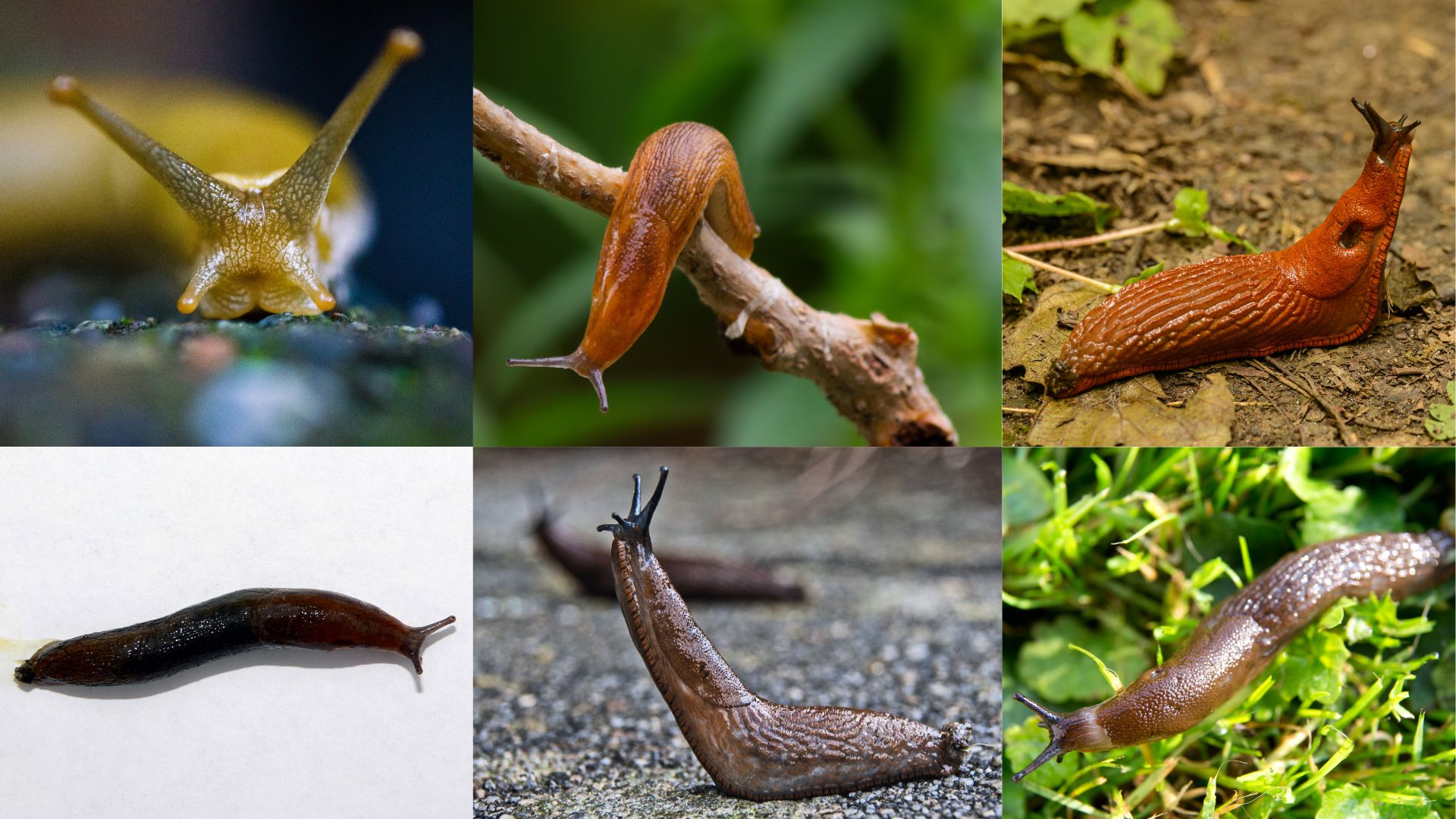 Here, slugs are depicted moving through the garden, demonstrating their unique shapes and the important role they play in the ecosystem.
Here, slugs are depicted moving through the garden, demonstrating their unique shapes and the important role they play in the ecosystem.
Unveiling the Secret Weapon of Snails and Slugs: How They Enrich Your Soil
Snails and slugs, often seen as garden pests, are actually silent superstars when it comes to soil health. These slow-movers play a vital role in decomposition, a natural process that breaks down organic matter like fallen leaves and dead plants. But how exactly do they achieve this feat, and how does it benefit your prized plants?
Unveiling the Anatomy of Snails and Slugs
The Decomposer Duo:
-
Shredding Crew: Snails and slugs munch on decaying plant material. Their radula, a rough, tongue-like organ, acts like a mini shredder, breaking down leaves and other organic matter into smaller pieces. This increases the surface area, making it easier for other decomposers like bacteria and fungi to access the nutrients within.
-
Mobile Mixers: As they move through the soil, snails and slugs physically mix organic matter with the mineral soil particles. This creates a more homogenous and aerated soil structure, allowing for better water infiltration and oxygen exchange – both crucial for healthy plant growth.
The Nutrient Cycle:
 Image of a compost pile with worms and castings
Image of a compost pile with worms and castings
-
Waste Not, Want Not: Snails and slugs digest the organic matter they consume, extracting some nutrients for their own growth. However, a significant portion of the ingested material passes through their digestive system and is eliminated as waste – castings.
-
Nature's Fertilizer: These castings are rich in nutrients like nitrogen, phosphorus, and potassium – essential elements for plant growth. Castings also contain beneficial microbes that further break down organic matter and make these nutrients even more readily available to your plants.
-
A Balanced Ecosystem: By facilitating decomposition and enriching the soil, snails and slugs contribute to a healthy and balanced ecosystem in your garden. This, in turn, benefits your desired plants by providing them with the nutrients they need to thrive.
Transforming Your Garden:
By allowing snails and slugs to play their natural role, you can:
- Reduce the need for chemical fertilizers: Their castings act as a natural fertilizer, saving you money and reducing your reliance on harsh chemicals.
- Improve soil structure: Their burrowing and mixing activities promote aeration and drainage, leading to healthier plant roots.
- Boost overall soil health: The breakdown of organic matter adds essential nutrients and beneficial microbes back into the soil, creating a thriving ecosystem for your plants.
So, the next time you see a snail or slug in your garden, remember – they're not just munching on your plants; they're silently working to create a richer, more fertile environment for your entire garden to flourish. Embrace these slimy superheroes and let them help you create a thriving backyard oasis!
2. Terrific Toads
 This composite image provides a fascinating visual journey through the life cycle of toads. Starting from the top left, we see a pair of adult toads in an amplexus embrace, where the male clasps the female in preparation for egg-laying. Next, on the top right, the results of their union are displayed: a clutch of toad eggs, recognizable by their black dots centered in transparent gelatinous orbs, gathered in water. The bottom left shows a tadpole, the larval stage of a toad, which lives fully in water and breathes through gills. In the middle of the bottom row, we have an older tadpole at a stage closer to metamorphosis, with back limbs formed, readying for life on land. Finally, on the bottom right, the image captures a mature toad perched on lily pads, fully transitioned to its adult form, completing the cycle of growth. This visual story beautifully encapsulates the remarkable transformation toads undergo from eggs to adults.
This composite image provides a fascinating visual journey through the life cycle of toads. Starting from the top left, we see a pair of adult toads in an amplexus embrace, where the male clasps the female in preparation for egg-laying. Next, on the top right, the results of their union are displayed: a clutch of toad eggs, recognizable by their black dots centered in transparent gelatinous orbs, gathered in water. The bottom left shows a tadpole, the larval stage of a toad, which lives fully in water and breathes through gills. In the middle of the bottom row, we have an older tadpole at a stage closer to metamorphosis, with back limbs formed, readying for life on land. Finally, on the bottom right, the image captures a mature toad perched on lily pads, fully transitioned to its adult form, completing the cycle of growth. This visual story beautifully encapsulates the remarkable transformation toads undergo from eggs to adults.
Unveiling the World of Toads: Beyond the Backyard Bug Zappers
Toads, those bumpy-skinned, warty amphibians, are much more than just garden guests. They're fascinating creatures with a rich history and a vital role in the ecosystem. Let's delve deeper into the world of toads:
Species Symphony:
There are over 500 known toad species worldwide, each with unique adaptations. Here are some interesting examples:
- American Toad (Anaxyrus americanus): A common sight in North America, known for its high-pitched trill.
- Cane Toad (Rhinella marina): The largest toad species, native to South America but introduced to other areas like Australia, where it can be invasive.
- Fire-bellied Toad (Bombina bombina): A European toad with a vibrant orange underside, a warning coloration to deter predators.
- Golden Mantella (Mantella aurum): A critically endangered Malagasy toad with bright yellow skin, a victim of the illegal pet trade.
Population Patterns:
Toad populations can vary greatly depending on the species and habitat. Some species can be quite abundant, while others are threatened or endangered due to habitat loss, pollution, and climate change.
Weather Warriors:
Toads are ectothermic, meaning they rely on external sources for warmth. They are most active during warm, damp nights when insects, their primary food source, are also abundant. During hot, dry periods, they may burrow underground or seek shelter in moist areas to stay hydrated.
Sounds of the Season:
The male toad's call is a loud, resonant trill or chirp, used to attract mates during breeding season. The specific sound can vary depending on the species. For example, the American toad has a high-pitched trill, while the woodhouse toad has a slower, bubbling call.
Mating and Metamorphosis:
Most toads reproduce in freshwater. Males attract females with their calls. After fertilization, the female lays long strings of eggs in the water. These eggs hatch into tadpoles, aquatic creatures with gills and tails. As tadpoles, they feed on algae and other aquatic plants. Over time, they undergo a remarkable metamorphosis, developing lungs and legs and losing their tails to become adult toads.
Growth Gears:
Toad growth varies by species and environmental factors. Generally, they reach adult size within 2-4 years. They can live for up to 10 years in the wild, with some species potentially exceeding that lifespan.
A Toad's Tale: A Historical Journey:
The fossil record suggests toads diverged from frogs millions of years ago. They have played a role in human cultures for centuries. In some cultures, toads are symbols of good luck and transformation, while in others, they are associated with warts and witchcraft.
Beyond Bug Zappers:
While toads are beneficial garden residents, they are not a one-size-fits-all solution for pest control. A healthy ecosystem with a variety of predators helps keep insect populations in check. Creating a toad-friendly habitat with a shallow pond or water feature can attract them naturally. However, avoid relying solely on toads to eliminate all your unwanted insects.
By appreciating the wonders of toads, we can learn to coexist with these fascinating creatures and contribute to the health of our local ecosystems. So, the next time you hear a toad's call on a warm evening, take a moment to appreciate these little bug-munching musicians and their vital role in the natural world.
3. Garden Snakes
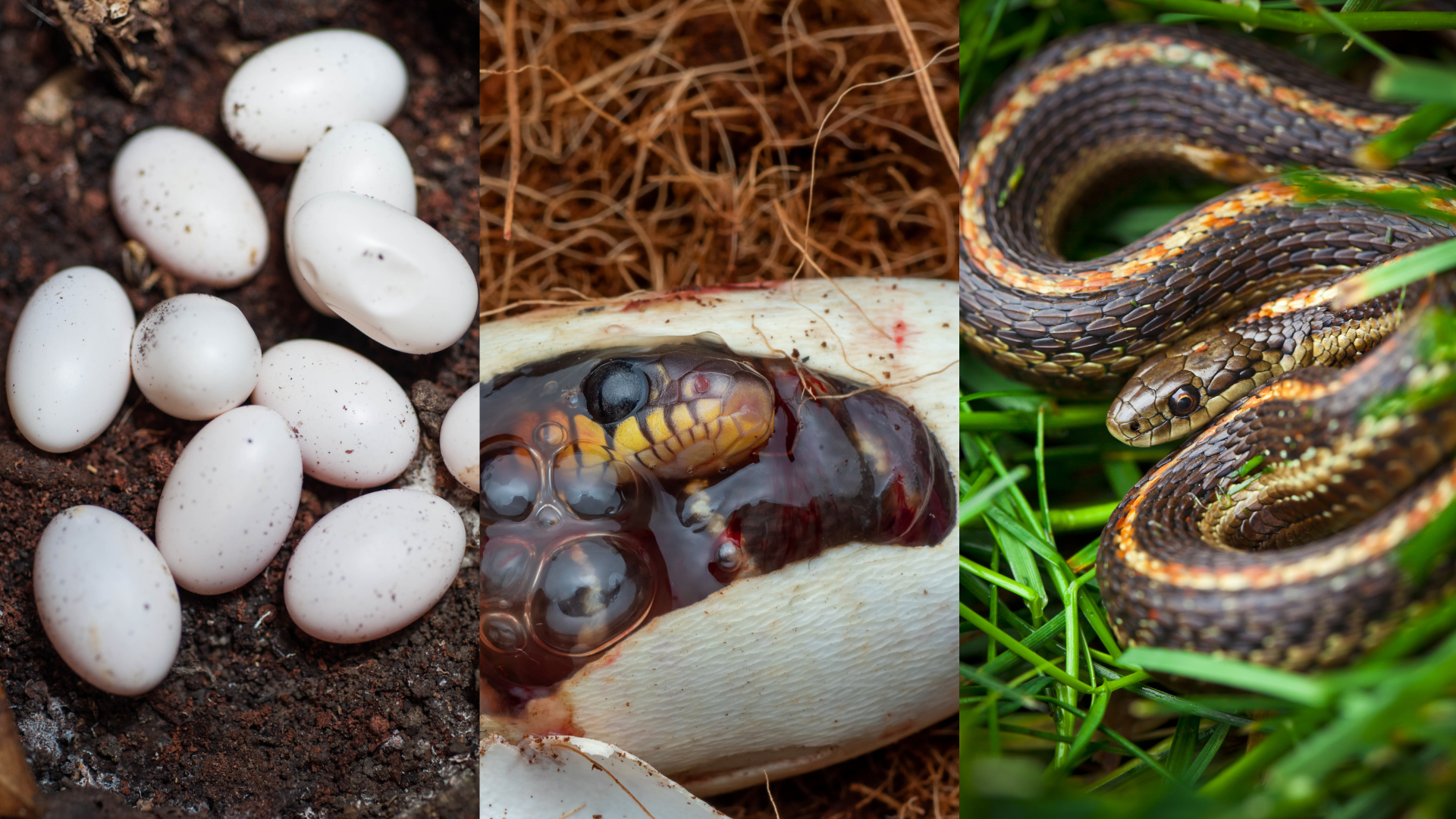 This compelling triptych captures the captivating life stages of a garden snake. On the left, we see a cluster of pristine white eggs nestled in the earth, the beginning of life for these reptiles. At the center, a dramatic moment is frozen in time as we witness the hatching of a snake; the young reptile, already displaying characteristic scales and patterns, is emerging from its egg, its eyes wide to the new world. Completing the story on the right, a mature garden snake is presented in full elegance, its body adorned with a mosaic of colors, gracefully winding across a bed of green grass. This visual narrative showcases the extraordinary transformation from egg, to hatchling, to adult in the natural environment.
This compelling triptych captures the captivating life stages of a garden snake. On the left, we see a cluster of pristine white eggs nestled in the earth, the beginning of life for these reptiles. At the center, a dramatic moment is frozen in time as we witness the hatching of a snake; the young reptile, already displaying characteristic scales and patterns, is emerging from its egg, its eyes wide to the new world. Completing the story on the right, a mature garden snake is presented in full elegance, its body adorned with a mosaic of colors, gracefully winding across a bed of green grass. This visual narrative showcases the extraordinary transformation from egg, to hatchling, to adult in the natural environment.
Unveiling the Garden Snake: Beyond the Backyard Basil Guardian
Garden snakes, with their slender bodies and quick movements, are often met with fear. However, these non-venomous reptiles play a valuable role in our backyards. Let's delve deeper into the fascinating world of garden snakes:
A Species Symphony:
There are over 40 species classified as garden snakes, belonging to various genera within the Colubridae family. Here are some common examples found in North America:
- Common Garter Snake (Thamnophis sirtalis): The most widespread North American snake species, known for its colorful stripes.
- Eastern Ribbon Snake (Thamnophis sauritus): A slender species with bright markings, often found near water.
- DeKay's Snake (Storeria dekayi): A small, brown snake with a keeled (ridged) back, common in woodlands and gardens.
- Rough Green Snake (Opheodrys aestivus): A bright green snake with a yellow belly, found in trees and shrubs.
Population Puzzles:
Garden snake populations can vary greatly depending on the species and habitat. Some species can be quite abundant in suitable areas, while others may be more localized or declining due to habitat loss and fragmentation.
Weather Warriors:
Like most reptiles, garden snakes are ectothermic (cold-blooded). They are most active during warm, sunny days when their prey, like rodents and insects, are also active. During colder weather, they may brumate (become inactive) and seek shelter underground or in rock crevices.
Sounds of Silence:
Unlike some snakes that hiss or rattle, garden snakes are generally silent creatures. They may puff up their bodies and hiss as a defensive display when threatened, but they don't produce any vocalizations.
Mating and Metamorphosis:
Garden snakes reproduce by laying eggs. Mating typically occurs in spring or early summer. The female lays a clutch of 4-20 leathery eggs in a hidden location like a compost pile or under rocks. The eggs incubate for several weeks, and the hatchlings are independent from birth, needing to hunt for their own food.
Growth Gears:
The growth rate of garden snakes varies depending on the species and food availability. However, most species reach sexual maturity within 2-3 years. Their lifespan can range from 5-10 years in the wild, with some individuals potentially living longer.
A Historical Connection:
Snakes have been around for millions of years, with fossil records of snake-like creatures dating back over 100 million years. Garden snakes, specifically, are believed to have evolved alongside rodents, their primary prey source. In many cultures, snakes are symbols of transformation and rebirth.
Identifying the Helpful and the Harmful:
While most garden snakes in North America are non-venomous and beneficial, there are a few venomous look-alikes. Here's what to keep in mind:
- Garden snakes: Round pupils, smooth scales, and a narrow head.
- Venomous look-alikes (Cottonmouths, Copperheads): Elliptical pupils, keeled scales (ridged), and a wider, triangular head.
When in doubt, leave it alone! Most snakes are more afraid of humans than we are of them. If you encounter a snake in your yard, it's best to observe it from a safe distance and allow it to go on its way.
Beyond the Basil Guardian:
Garden snakes are excellent rodent control specialists. They can help keep populations of mice and voles in check, which can be beneficial for gardens and homes. By providing them with hiding spots like rock piles or brush piles, you can create a welcoming habitat for these helpful backyard residents.
By understanding and appreciating garden snakes, we can learn to coexist with these fascinating creatures. They are not just backyard basil protectors, but important players in maintaining a healthy ecosystem.
4. Wriggling Worms
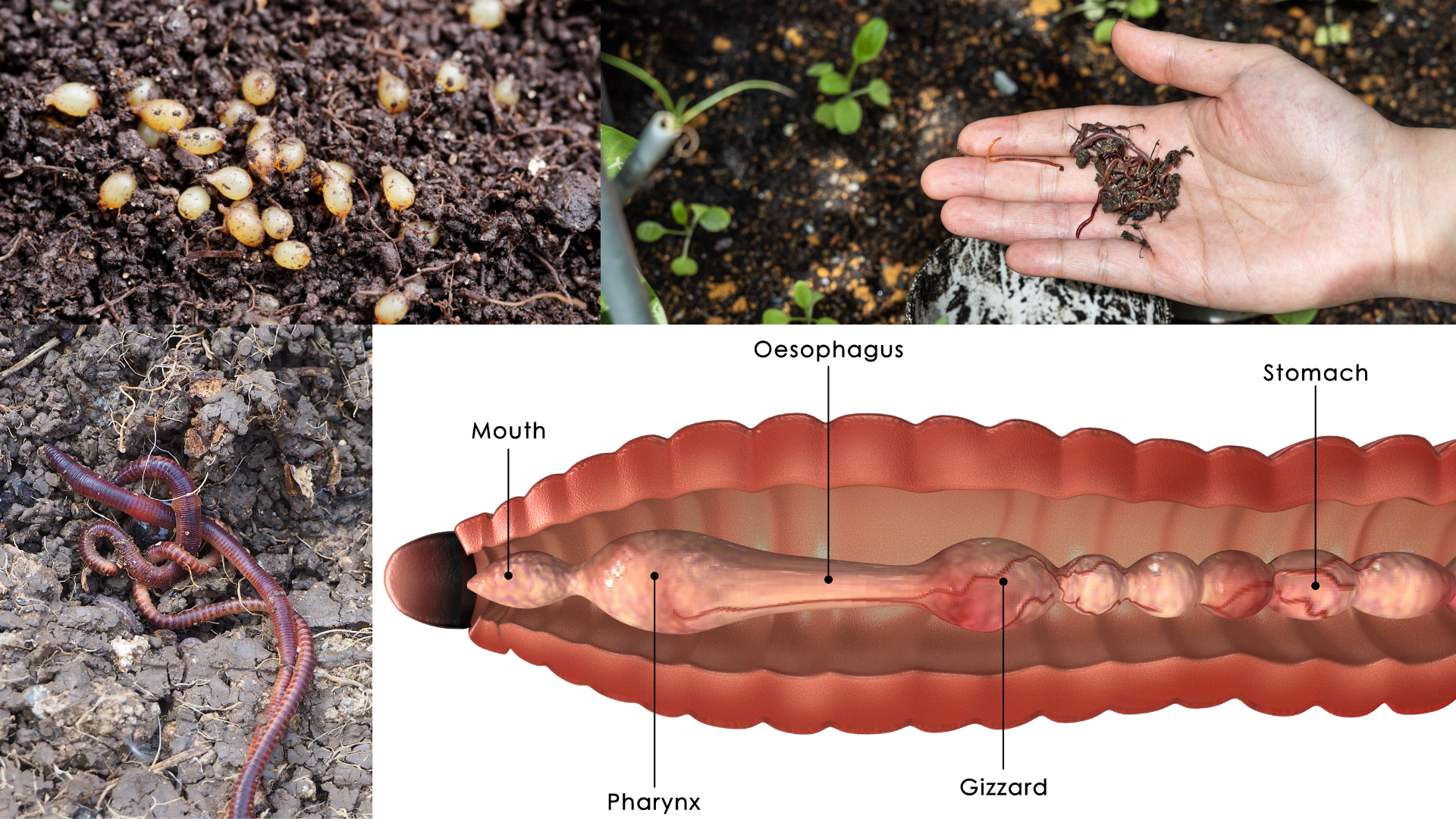
This composite image provides an educational glimpse into the lifecycle and anatomy of an earthworm. In the upper left, we see earthworm eggs nestled in fertile soil, oval and lightly colored, ready to hatch. The upper right portion of the image presents adult earthworms, wriggling on a human palm, showcasing their size and segmented bodies. Below, a singular earthworm is seen on soil, giving context to its natural habitat and behavior.
Central to the image is a detailed cross-sectional diagram of an earthworm, scientifically labeled to illustrate its internal structure. The labels "Mouth," "Oesophagus," "Pharynx," "Gizzard," and "Stomach" indicate the progression of the digestive system, from ingestion to digestion. This diagram provides a clear understanding of how the earthworm processes soil and organic matter, which in turn benefits the ecosystem through soil aeration and nutrient cycling. Together, these visuals celebrate the humble yet critical role earthworms play in enriching the earth beneath our feet.
Unveiling the Wriggling Wonders: Earthworms and the Secret to Thriving Soil
Earthworms, those tireless burrowers, are much more than just creepy crawlies in the dirt. They're ecosystem engineers, playing a vital role in soil health and fertility. Let's delve into the fascinating world of earthworms:
A Species Symphony:
There are over 4,400 known earthworm species worldwide, each with unique adaptations to their environment. Here are a few common examples found in North America:
- Nightcrawler (Lumbricus terrestris): A large, reddish-brown worm known for its surface activity at night.
- Eisenia worms (Eisenia fetida and Eisenia andrei): These composting worms are smaller and lighter in color, ideal for breaking down organic matter in compost bins.
- Jumping worms (Amynthas spp.): An invasive species in some areas, known for their erratic movements when disturbed.
Population Puzzles:
Earthworm populations can vary greatly depending on the soil quality, climate, and land management practices. Healthy soils can support thousands of earthworms per square meter, while degraded soils may have very few.
Weather Warriors:
Earthworms are sensitive to moisture and temperature. They are most active during warm, moist periods when the soil is soft and easy to burrow through. During dry periods, they may burrow deeper into the soil to access moisture or enter a state of dormancy.
Sounds of Silence:
Earthworms are silent creatures. They communicate through touch and chemical signals.
Mating and Metamorphosis:
Earthworms are hermaphrodites, meaning they have both male and female reproductive organs. They exchange sperm during mating, and each worm lays a cocoon containing fertilized eggs. The cocoons hatch into tiny, white worms that mature into adults over time.
Growth Gears:
The growth rate of earthworms varies depending on the species and food availability. However, most species reach maturity within a few months. Their lifespan can range from 1-8 years, with some even exceeding that in ideal conditions.
A Historical Connection:
Earthworms have been around for millions of years, playing a crucial role in soil formation and ecosystem health. Charles Darwin, the famous naturalist, even wrote a book titled "The Formation of Vegetable Mould, Through the Action of Worms," highlighting their significance.
Identifying the Helpful and the Harmful:
While most earthworm species are beneficial, a few invasive species can cause problems. Jumping worms, for example, can disrupt soil structure and displace native earthworm populations.
Enriching the Soil:
Earthworms are champions of soil aeration and nutrient cycling. Here's how they achieve this remarkable feat:
- Tunneling Troopers: As earthworms burrow through the soil, they create channels that allow air and water to infiltrate deeper layers. This improves drainage and root respiration for plants.
- Waste Not, Want Not: Earthworms ingest soil and organic matter like dead leaves and compost. They digest the organic material, extracting nutrients, and eliminate the rest as castings (worm poop).
- Nature's Fertilizer: Castings are rich in nutrients like nitrogen, phosphorus, and potassium – essential elements for plant growth. They also contain beneficial microbes that further break down organic matter and make these nutrients even more readily available to plants.
- Mixing Masters: Earthworms constantly move soil particles as they burrow. This mixing action helps create a more homogenous soil structure, improving drainage and nutrient availability throughout the soil profile.
By enriching the soil with their tireless activities, earthworms create a thriving environment for plants to flourish.
Attracting these Wriggling Wonders:
To attract earthworms to your garden, consider these tips:
- Compost Power: Create a compost bin and add food scraps, yard waste, and other organic materials. Earthworms love to feast on decomposing matter and will readily take up residence in your compost pile.
- Mulch Magic: Apply a layer of organic mulch around your plants. This helps retain moisture, suppress weeds, and provides a food source for earthworms as it decomposes.
- Minimize Tilling: Excessive tilling can damage earthworm populations. Consider no-till gardening practices or minimal disturbance of the soil.
By understanding and appreciating earthworms, we can learn to create a healthy and vibrant garden ecosystem. So, the next time you see a wriggling worm, remember – they're not just creepy crawlies; they're silent superstars working tirelessly to create a fertile haven for your plants to thrive.
5. Birds

This vivid montage showcases a delightful array of common North American backyard birds, accompanied by a bird feeder, each species a testament to the diversity of avian life in suburban and rural settings.
In the upper left, we have the Northern Cardinal (Cardinalis cardinalis), its radiant red plumage and crested head a striking presence. This songbird is often a cherished guest at bird feeders. Next, the American Robin (Turdus migratorius) stands out with its warm reddish-orange breast and gray back, heralding the arrival of spring as it forages on the ground.
The House Finch (Haemorhous mexicanus), featured in the upper right, sports a rosy red head and breast with streaks along its sides, frequently spotted at feeders where it comes for seeds. The central image is dedicated to a bird feeder brimming with a mix of seeds, inviting an assortment of birds to feast.
On the lower left, the Mourning Dove (Zenaida macroura), with its soft grayish-brown feathers and distinctive black spots on the wings, exudes a sense of serenity. Its gentle coo often adds a touch of tranquility to the dawn chorus. Lastly, the Black-capped Chickadee (Poecile atricapillus) is easily recognized by its black cap and white cheeks. Its playful energy and familiar call are a delight to bird watchers.
Together, these species contribute to the ecological tapestry of the area, participating in seed dispersal, pest control, and adding melodious songs to the environment. The bird feeder serves as a central hub for these avian wonders, providing nourishment and opportunities for observation and study.
Feathered Friends: Unveiling the Symphony in Your Backyard
Birds, with their vibrant plumage and captivating songs, are more than just pretty decorations in your backyard. They are vital players in the ecosystem, and attracting them can bring a touch of magic and wonder to your outdoor space. Let's delve into the world of North American birds:
A Species Symphony:
North America boasts a staggering diversity of birds, with over 800 species calling this region home. Here are just a few examples you might encounter in your backyard:
- Northern Cardinal (Cardinalis cardinalis): A vibrant red songbird with a distinctive crest, a common sight at feeders.
- American Robin (Turdus migratorius): A familiar songbird with a reddish breast, known for its early spring arrival.
- House Finch (Haemorhous mexicanus): A reddish-brown finch with streaked underparts, a frequent visitor to feeders.
- Black-capped Chickadee (Poecile atricapillus): A small, energetic songbird with a black cap and white bib, known for its "chick-a-dee-dee-dee" call.
- Mourning Dove (Zenaida macroura): A plump, grayish-brown dove with a mournful cooing call.
Population Puzzles:
Bird populations can fluctuate significantly depending on the species, habitat quality, and food availability. Some species are common and widespread, while others are threatened or endangered due to habitat loss, pollution, and climate change.
Weather Warriors:
Birds are warm-blooded creatures, meaning they regulate their body temperature internally. Many bird species are highly attuned to weather patterns. Some, like robins, migrate south for the winter to escape harsh conditions and find food sources. Others, like chickadees, have adaptations to survive cold winters, such as growing thicker feathers and lowering their body temperature at night.
Sounds of the Season:
Birds are known for their beautiful songs and calls. These vocalizations serve various purposes, including attracting mates, defending territories, and communicating with other birds. The type of sound a bird makes can vary depending on the species, context, and season. For example, a male cardinal's song is loud and complex, used to attract a mate, while a chickadee's "chick-a-dee-dee" call is a contact call used to stay in touch with flock members.
Mating and Metamorphosis:
Most bird species reproduce by laying eggs in a nest. Mating rituals can be elaborate, involving displays of song, plumage, and acrobatics. The female lays a clutch of eggs, which are incubated by the parents (or sometimes just the female) for a period of time that varies depending on the species. After hatching, the chicks are altricial, meaning they are helpless and require parental care for food and warmth. Over time, they grow feathers and learn to fly, eventually becoming independent.
A Historical Connection:
Birds have a long and fascinating history with humans. They have been featured in art, literature, and mythology for centuries. Birds have also played a role in human advancement, inspiring inventions like airplanes and hot air balloons.
Identifying Backyard Beauties:
Identifying birds in your backyard can be a fun and rewarding challenge. There are many resources available online and in field guides to help you learn about different bird species and their characteristics. Pay attention to size, shape, color patterns, markings, and behavior to narrow down your identification.
Enriching Your Backyard:
Here are some things you can do to attract birds to your backyard and create a haven for them:
- Food for Feathered Friends: Install bird feeders with a variety of seed types to cater to different bird species. Black-oil sunflower seeds are a favorite of many birds, while thistle seed attracts finches. Suet feeders can attract woodpeckers and other insect-eating birds. Offer hummingbird feeders filled with a sugar-water solution for these dazzling visitors.
- Nesting Nirvana: Provide nesting spots for birds by placing birdhouses strategically around your yard. Different bird species prefer different types of houses, so consider researching the needs of birds in your area.
- Water Works: Birds need water for drinking and bathing. Consider adding a birdbath to your yard and keeping it clean and fresh.
- Plant Power: Plant native trees, shrubs, and flowers that provide food and cover for birds. Berries, nuts, and nectar-producing flowers are all attractive to different bird species.
- Minimize Pesticides: Pesticides can harm birds and their food sources. Use natural pest control methods whenever possible.
Migration Marvels:
Many North American bird species are migratory, meaning they travel long distances between breeding and wintering grounds. These migrations are triggered by changes in daylight hours and food availability. Understanding
6. Chirping Crickets
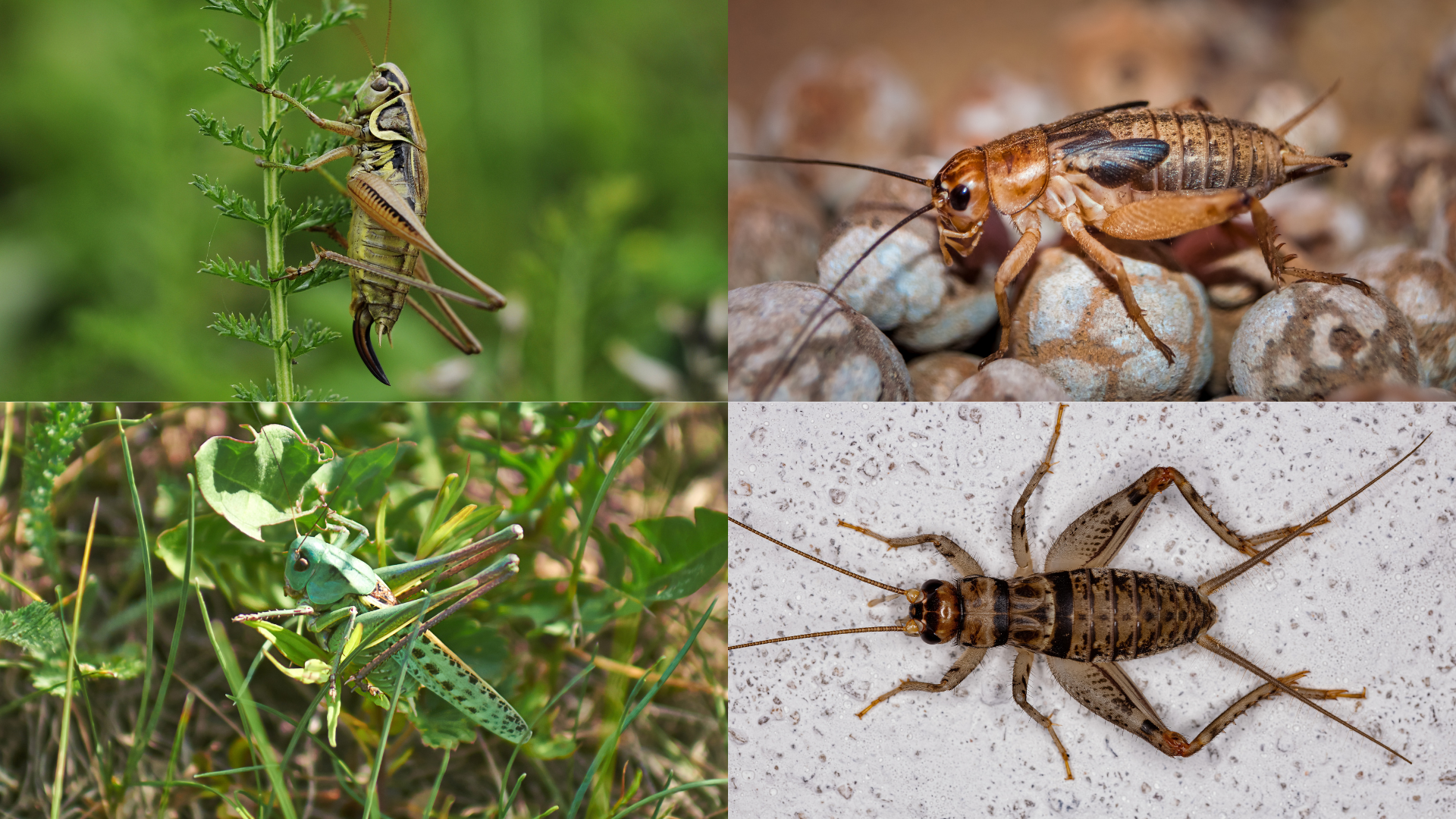
This image is a vivid showcase of the diversity among cricket species. In the top left, we observe a cricket perched delicately on a plant stem, its body sporting the typical elongated hind legs used for its characteristic jumping ability. The top right image captures a cricket navigating a rocky terrain, its antennas outstretched, possibly sensing its environment. The bottom left photo features a strikingly green cricket, blending almost seamlessly with the leaf it rests upon—a master of camouflage. Finally, the bottom right picture presents a cricket on a pale surface, its spotted body and transparent wings a contrast to the uniform background, highlighting the insect's complex exoskeletal structure. Each of these images exemplifies the unique physical attributes that crickets possess, adapting them to their respective environments.
Crickets: Beyond the Chirping Chorus in Your Backyard
Crickets, those nocturnal insects with their distinctive chirp, are more than just occasional houseguests. They're vital players in the outdoor ecosystem, and understanding their role can help us appreciate their presence in our backyards.
Species Symphony:
Over 2,000 cricket species exist worldwide, with several dozen calling North America home. Here are a few common examples:
- Field Cricket (Gryllus pennsylvanicus): A large, black cricket with a loud chirp, often found in fields and meadows.
- House Cricket (Acheta domesticus): A smaller, yellowish-brown cricket known to find its way indoors, attracted by warmth and moisture.
- Tree Cricket (Oecanthus spp.): Greenish crickets with a high-pitched trill, found on trees and shrubs.
Population Puzzles:
Cricket populations can fluctuate greatly depending on the species and habitat quality. Favorable weather conditions and abundant vegetation can lead to population booms, while harsh winters or habitat loss can cause declines.
Weather Warriors:
Crickets are cold-blooded insects, meaning their body temperature depends on the environment. They are most active during warm nights when they can chirp and search for food. During cold weather, they may burrow underground or seek shelter in protected areas to avoid freezing.
Sounds of the Season:
The male cricket's chirp is an iconic sound of summer nights. It's created by rubbing a scraper on their forewing against a file on their hind wing. This chirp serves to attract mates and defend territories. Different cricket species have unique chirping patterns, allowing them to identify each other.
Mating and Metamorphosis:
Crickets reproduce by laying eggs in the soil. After hatching, the young crickets, called nymphs, go through several molting stages before reaching adulthood. Unlike butterflies, crickets don't undergo a complete metamorphosis. They gradually develop wings and reproductive organs as they molt.
A Historical Connection:
Crickets have been around for millions of years. They have featured in various cultures throughout history, sometimes as symbols of good luck and sometimes as pests. In China, crickets were even kept as pets in elaborately decorated cages.
Identifying Backyard Chirpers:
Crickets can be identified by their size, color, and chirp pattern. Field guides or online resources can help you distinguish between different species in your area.
Enriching the Backyard:
While sometimes seen as a nuisance indoors, crickets play a valuable role in the outdoor food chain. Here's how they contribute:
- Food Chain Champions: Crickets are a vital food source for birds, lizards, frogs, bats, and other animals. Their abundance helps maintain a healthy balance in the ecosystem.
- Decomposers: Crickets feed on decaying plant matter, contributing to the decomposition process and returning nutrients to the soil.
Creating a Cricket-Friendly Habitat:
While attracting large numbers of crickets indoors isn't desirable, you can create a welcoming environment for them in your backyard:
- Leave a Refuge: Maintain a small patch of tall grass or other vegetation at the edge of your yard. This provides them with shelter and breeding grounds.
- Minimize Pesticides: Avoid using pesticides in your yard, as these can harm crickets and other beneficial insects.
Beyond the Backyard:
Crickets are a fascinating group of insects that play a crucial role in the natural world. By understanding and appreciating them, we can coexist peacefully and create a healthier ecosystem for all creatures, including ourselves.
7. Crawly Caterpillars
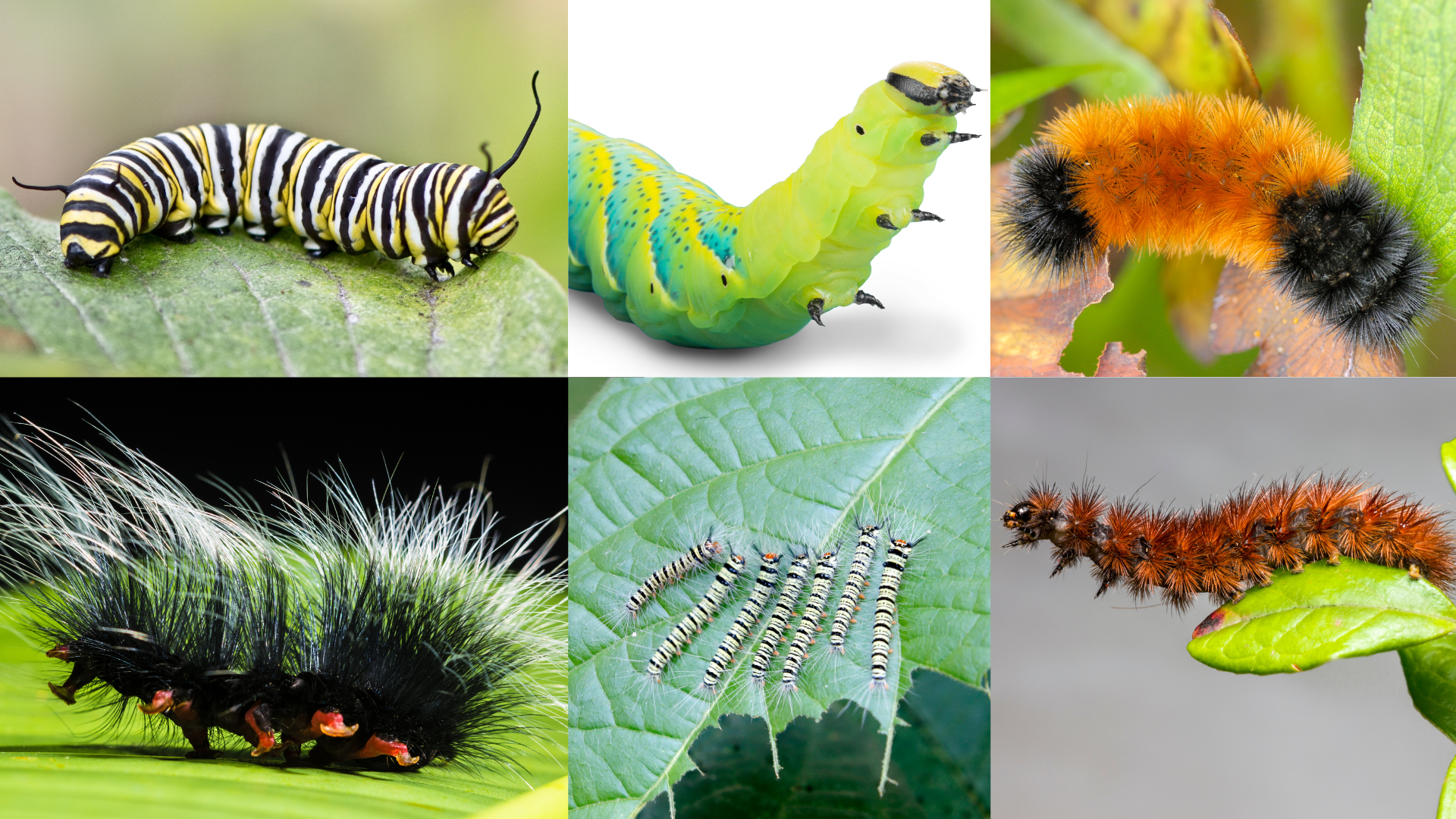
This vibrant collection captures the astonishing variety of caterpillars, each stage a precursor to the beauty of butterflies and moths. In the upper left, we see the iconic black, white, and yellow stripes of the Monarch caterpillar, a species renowned for its remarkable migration. Adjacent on the right, a caterpillar flaunts an extraordinary palette of bright greens and blues, punctuated with spots of black and orange—a spectacular display of nature's artistry.
The top right shows a fluffy caterpillar, its body a rich orange with tufts of black hair that may provide defense against predators. Below, on the bottom left, we encounter a caterpillar with an outlandish hairdo of long, silky hairs, its appearance warning potential predators of its possible toxicity.
In the center of the bottom row, a procession of caterpillars munches away on green leaves, a testament to their role in the ecosystem as both consumers and future pollinators. Lastly, the image on the bottom right features a fuzzy caterpillar in a warm russet tone, its spiky exterior yet another example of the diverse adaptations these creatures possess for survival.
Crawly Caterpillars: Unveiling the Jewels of Transformation in Your Backyard
Caterpillars, those often brightly colored and intriguing inchworms, are more than just garden nibblers. They are the fascinating larval stage of butterflies and moths, undergoing a remarkable metamorphosis before taking flight. Let's delve deeper into the world of these backyard jewels:
Species Symphony:
There are over 15,000 known caterpillar species worldwide, with hundreds calling North America home. Each butterfly and moth species has its own unique caterpillar form. Here are a few interesting examples:
- Monarch Butterfly Caterpillar (Danaus plexippus): Black, yellow, and white striped caterpillar that feeds on milkweed plants.
- Spicebush Swallowtail Caterpillar (Papilio troilus): Green caterpillar with orange spots and black markings, found on spicebush and sassafras trees.
- Eastern Tent Caterpillar (Malacosoma americanum): Hairy brown or black caterpillar that lives in communal silken tents on trees in early spring.
Population Puzzles:
Caterpillar populations can vary greatly depending on the species, host plant availability, and weather conditions. Some species are quite abundant, while others are rare or threatened due to habitat loss and pesticide use.
Weather Warriors:
Caterpillars are cold-blooded insects. Their activity level depends on the temperature. During warm days, they actively feed and grow. In cooler weather, they may become less active or enter a state of diapause (dormancy) to survive colder temperatures.
Sounds of Silence:
Unlike adult butterflies and moths, caterpillars are generally silent creatures. They communicate chemically, leaving pheromone trails to locate food and mates.
Mating and Metamorphosis:
Adult butterflies and moths lay eggs on plants that will serve as food for the developing caterpillars. After hatching, the caterpillar goes through several molting stages, growing larger with each molt. Finally, they spin a silken cocoon or chrysalis (for butterflies) or burrow underground (for some moth species) and undergo a remarkable transformation – metamorphosis. Inside the cocoon or chrysalis, the caterpillar's body breaks down and reassembles into an adult butterfly or moth.
A Historical Connection:
Caterpillars have been around for millions of years, playing a vital role in the ecosystem. They have featured in various cultures throughout history, often symbolizing transformation and rebirth. In some cultures, caterpillars were even considered a food source.
Identifying Backyard Beauties:
Caterpillars can be identified by their size, color patterns, body shape, and the types of plants they feed on. Field guides or online resources can help you distinguish between different species in your area.
Enriching the Backyard:
Caterpillars are an essential part of the pollinator life cycle. Here's how they contribute to your backyard haven:
- Pollinator Power: When caterpillars transform into butterflies and moths, these adult insects become important pollinators. They transfer pollen between flowers as they feed on nectar, helping plants reproduce.
- Food Chain Fare: Caterpillars themselves are a food source for many animals, including birds, lizards, and spiders. Their presence helps maintain a healthy balance in the ecosystem.
Creating a Caterpillar Paradise:
- Plant a Pollinator Buffet: Plant a variety of native flowers and herbs that bloom throughout the growing season. This provides a food source for both adult butterflies and moths and their developing caterpillars. Milkweed is a critical food source for Monarch butterflies, while asters and goldenrod attract many other species.
- Minimize Pesticides: Avoid using pesticides in your yard, as these can harm caterpillars and other beneficial insects. Consider natural pest control methods whenever possible.
- Respect the Process: While some caterpillars can be garden pests, many are beneficial. If you find caterpillars on your plants, try to identify them. If they are not a serious threat, allow them to complete their metamorphosis and contribute to the ecosystem.
By attracting caterpillars to your yard, you can witness the wonder of metamorphosis firsthand and contribute to a healthy pollinator population. These crawly creatures are not just garden nibblers; they are the jewels of transformation, enriching our backyards with their beauty and ecological significance.
8. Flashing Fireflies
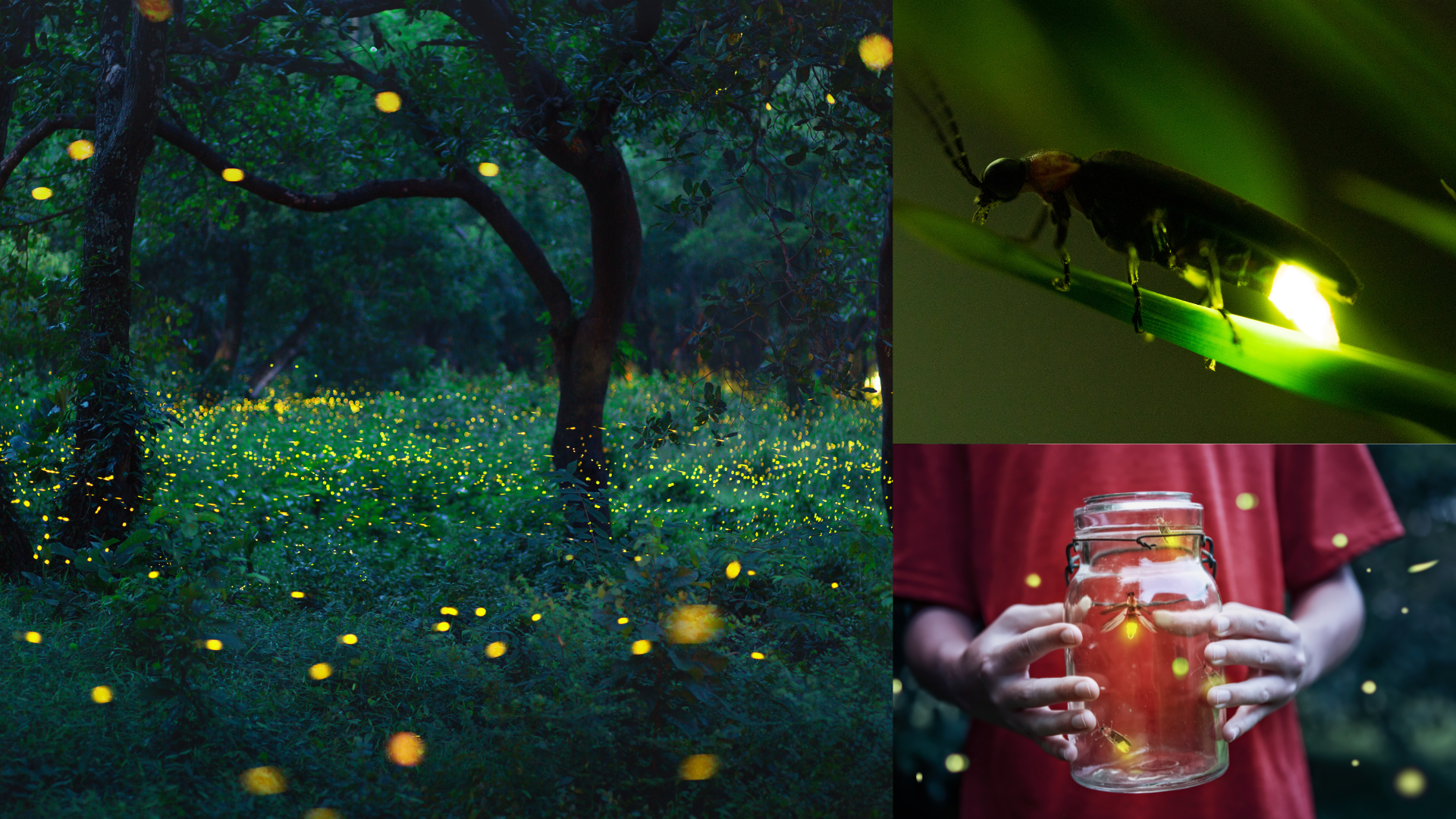
Flashing Fireflies: Illuminating the Wonders in Your Backyard
Fireflies, those twinkling beacons of summer nights, are more than just dazzling displays of bioluminescence. They're fascinating beetles with a unique light show and an important role in the ecosystem. Let's delve into the world of these glowing wonders:
Species Symphony:
Over 2,000 firefly species exist worldwide, with hundreds lighting up the night skies of North America. Here are a few common examples:
- Big Dipper Firefly (Photinus pyralis): A common eastern North American species with a yellow flash pattern.
- Eastern Firefly (Photinus carolinus): Another widespread species known for its synchronous flashing displays.
- Blue Ghost Firefly (Phausis scintillans): A unique firefly with bioluminescent larvae that glow blue.
Population Puzzles:
Firefly populations can vary greatly depending on the species and habitat quality. Light pollution is a major threat, disrupting their mating rituals and reducing their numbers. Land development and pesticide use can also contribute to population decline.
Weather Warriors:
Fireflies are cold-blooded insects. Their activity level is highly dependent on temperature. They are most active during warm, humid nights when they can fly and flash their lights efficiently. Colder weather restricts their activity, and they may take shelter in leaf litter or under logs.
Sounds of Silence:
Fireflies are generally silent creatures. Their communication relies on light signals. The flashing patterns of their lights vary by species and serve to attract mates.
Mating and Metamorphosis:
Adult fireflies emerge from the ground after spending their larval stage as glowing worms in the soil. Mating typically occurs at night, with males using their flashing patterns to attract females. After mating, the female lays eggs in moist soil or vegetation. The eggs hatch into larvae that are bioluminescent as well. Over time, the larvae go through several molting stages before pupating and emerging as adult fireflies.
A Historical Connection:
Fireflies have captivated humans for centuries. They have featured in folklore, literature, and art across various cultures, often symbolizing light, hope, and transformation. Early scientific studies even used fireflies in attempts to create artificial light.
Identifying Backyard Beacons:
Fireflies can be identified by their size, color, flash pattern, and activity time. Fireflies are often confused with glowworms, which are the wingless, larval stage of a different beetle family. Field guides or online resources can help you distinguish between different firefly species in your area.
Enriching the Backyard:
Fireflies are more than just a whimsical summer spectacle; they play a role in the ecosystem:
- Predatory Prowess: Firefly larvae are predators, feeding on snails, slugs, and other small invertebrates. They help control these populations and maintain a healthy balance in the ecosystem.
- Food for the Food Chain: Adult fireflies are a food source for some animals like bats and birds.
Creating a Firefly Haven:
Light pollution is a major threat to fireflies. Here's how you can create a welcoming environment for them:
- Minimize Night Lighting: Turn off unnecessary outdoor lights at night, especially during peak firefly season. Shielding existing lights can help reduce light pollution.
- Embrace Native Plants: Plant native trees, shrubs, and flowers that provide moisture and shelter for fireflies.
- Create a Water Feature: A small pond or water source can attract fireflies, especially those that lay their eggs in moist environments.
By minimizing light pollution and creating a natural habitat, you can help fireflies continue their dazzling displays and contribute to a healthier ecosystem in your own backyard. Remember, these flashing fireflies are not just a fleeting summer wonder; they are bioluminescent ambassadors, reminding us of the beauty and delicate balance of the natural world.
By incorporating these simple tips and creating a welcoming habitat, you can transform your backyard into a haven for a variety of fascinating creatures. From the silent decomposers to the chirping musicians, each plays a vital role in the web of life. So, embrace the slimy, the slithery, the wriggling, and the chirping – and watch your backyard come alive!